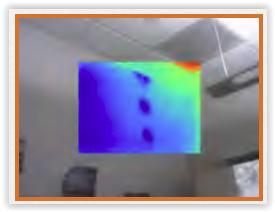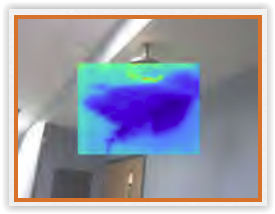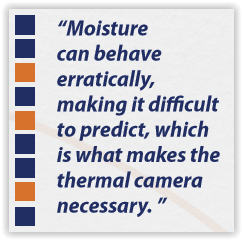Smile for the Camera
THERMAL IMAGING AND BUILDING SCIENCE
 Several years ago, thermal cameras became accessible to the general population, and I decided to invest in one for my work. You might have seen thermal cameras used on some TV show about the Army or a SWAT team. The characters will be scoping out a building, and someone in charge will demand they get thermal cameras on the building to see what’s going on inside. Within moments, another character reports they see two adults and a child moving around on the second floor, or something similarly revealing. This looks really cool. Unfortunately, it’s complete science fiction. In fact, seeing through a wall would be almost the opposite of what I need my thermal camera to do when I’m working on a site!
Several years ago, thermal cameras became accessible to the general population, and I decided to invest in one for my work. You might have seen thermal cameras used on some TV show about the Army or a SWAT team. The characters will be scoping out a building, and someone in charge will demand they get thermal cameras on the building to see what’s going on inside. Within moments, another character reports they see two adults and a child moving around on the second floor, or something similarly revealing. This looks really cool. Unfortunately, it’s complete science fiction. In fact, seeing through a wall would be almost the opposite of what I need my thermal camera to do when I’m working on a site!
In the simplest terms, my thermal camera lets me check the temperature of a surface, usually a certain spot  on a wall. This information helps me determine if there’s air leaking in or out of the building, or if there’s moisture behind the drywall. I’m able to achieve this by using my camera to get a reading in one place before checking the temperature in another location. If the first reading comes back at 72.5 degrees Fahrenheit and the next drops to 71, 70, or even 68.6 degrees, then I know there’s a problem. We then use handheld meters to confirm that moisture is causing the temperature difference.
on a wall. This information helps me determine if there’s air leaking in or out of the building, or if there’s moisture behind the drywall. I’m able to achieve this by using my camera to get a reading in one place before checking the temperature in another location. If the first reading comes back at 72.5 degrees Fahrenheit and the next drops to 71, 70, or even 68.6 degrees, then I know there’s a problem. We then use handheld meters to confirm that moisture is causing the temperature difference.
When I first bought my camera in 2007, I also took a five-day course from a company which provided thermal imaging training, followed by a two-day course to focus on thermal imaging as it relates to building science. The investment cost me over $20,000, but it’s been worth it. I’ve primarily used the camera for finding moisture, which can be a real challenge. As a colleague of mine puts it, “Water will go downhill, unless it decides to go sideways or up.”
 Moisture can behave erratically, making it difficult to predict, which is what makes the thermal camera necessary. Some time ago, I was called out to a 28-story building which had suffered a water leak in the men’s restroom on the 25th floor. The water restoration team wanted me to use the thermal camera to check for water in the walls — what they call moisture mapping. Though they had shut off the water right away, I still found water in the stairwell all the way down to the 15th floor!
Moisture can behave erratically, making it difficult to predict, which is what makes the thermal camera necessary. Some time ago, I was called out to a 28-story building which had suffered a water leak in the men’s restroom on the 25th floor. The water restoration team wanted me to use the thermal camera to check for water in the walls — what they call moisture mapping. Though they had shut off the water right away, I still found water in the stairwell all the way down to the 15th floor!
Two days later, they brought me back to check the drying. This time, I found the water had continued to move down to the 10th floor. Then, I was back again two days later to report that, while everything was drying properly, the water had migrated down to the seventh floor. That leak from Saturday morning managed to get down 18 flights of stairs by Tuesday! Without the thermal camera, no one would have realized it until the moisture in the walls started to cause problems.
This building was a fascinating case, as I’d never seen water behave so extremely before. That being said, it wasn’t the first time my thermal camera helped me identify potential problems before they got out of hand. My camera is 12 years old, and while it might not let me see through walls, it still works like a charm, and I wouldn’t be nearly as efficient without it.

